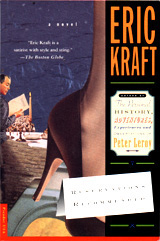
YOU CAN READ
|
In front of the library two boys are fighting. They are small and thin, one black, the other Vietnamese. The larger boy is clutching the smaller one’s neck. He has a look of odd detachment, shows no anger. The little one is choking. About forty adults are watching, waiting for a bus. Matthew feels that he should do something. He walks over to the boys, saying, “Hey, hey. Cut that out,” speaking with the voice of reason, as a peacemaker. The boys ignore him. A large man, who strikes Matthew as quite likely a high school football coach, walks up to the boys and bellows at the larger, “You little shit! Get your fucking hands off him!” He smacks the boy on the head, and the boy releases his choking grip. The smaller one drops to his knees and retches into the gutter. “Get out of here!” the coach shouts at the larger boy. He takes a fearful step backward and seems about to cry, but pride toughens him, and he tries to look defiant. More quietly, but with real menace in his voice, the coach says, “Get the fuck out of here.” The boy runs away. Matthew’s about to say that his method would have worked, too, when the coach looks at him and snorts. Matthew’s certain now that the man is a coach, because this is the same snort Matthew’s high school gym teacher used to make when Matthew handed him a note asking that he be excused from gym with an upset stomach. Now that Matthew has seen a little of the world, he knows that bulls and even bison snort this way. From coaches, this bull snort means, approximately, “Stay out of my range, you fuckin’ pansy.” Matthew walks on, but at the corner he makes another stop, to read some work of the writer he calls the Neat Graffitist. The Graffitist leaves messages all over Boston, printed in small, precise capital letters. He always uses a black marker, and he favors smooth surfaces free of other graffiti. He’s especially fond of the metal boxes that house traffic light controls, but sometimes he uses the sides of newspaper vending boxes. His work combines elements of a personal philosophy, pronouncements exhortatory and cautionary, snapshots of contemporary life, and bits of autobiography. The result is varied, intriguing, and mad. This is the message that stops Matthew: NEVER FEAR PAIN. TIME DIMINISHES IT. BUT AVOID BOSTON CITY HOSPITAL. NURSES THERE WEAR USED UNIFORMS PURCHASED FROM BURGER KING, TREAT PATIENTS WITH FATALISTIC DETACHMENT.Considering this on the way home, with the plastic handles digging into his hands at each step, Matthew decides that the heart of the message is the business about fatalistic detachment. That must be what’s really bothering the Graffitist, not the used uniforms purchased from Burger King. Matthew has been collecting the works of the Neat Graffitist for some time, memorizing them in the field and writing them down when he gets home. (He wouldn’t like to be seen copying them on the street.) His current theory is that the Graffitist is someone well educated who snapped at a period of high stress—in the middle of the oral defense of his doctoral thesis, say, or while expounding a marketing plan for a toy Burger King franchise. (Not a bad idea, it occurs to Matthew—movable action figures for the manager, teenage crew, off-duty nurses eating lunch. Uniforms sold separately. Tiny burgers, buns, fries, and shakes—also sold separately.) Why does he single out Boston City Hospital? Matthew asks himself. Maybe he was a patient there. Maybe he worked there as an orderly. Maybe he was a doctor there, a brain surgeon, driven mad by the escalating cost of malpractice insurance. That’s a long shot, but certainly isn’t impossible. Several themes run through the Graffitist’s oeuvre: the paranoiac fretting of someone who feels he’s being watched, criticized, harassed; loneliness and a desire for friendship; and the everyday indignities visited on the vulnerable. At times, he seems to be giving advice for good living, from one who has failed to live as he hoped he would. ON THIS CORNER AGENTS OF THE INTERNATIONAL LADIES GARMENT WORKERS UNION OBSERVE SOCIAL DEVIANTS. THEY MAKE NOTES, AND TAKE PICTURES. I DON’T THINK THEY HAVE A PROPER RESPECT FOR THE CHARACTERS OF OTHERS. |
 |
||
|
RESERVATIONS
RECOMMENDED | CHAPTER 2, PART 2 | CONTENTS
PAGE
|

 Here
are a couple of swell ideas from Eric Kraft's vivacious publicist, Candi
Lee Manning:
Here
are a couple of swell ideas from Eric Kraft's vivacious publicist, Candi
Lee Manning:
